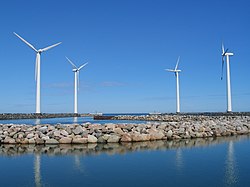Price-of-electricity-new-renewables-vs-new-fossil-no-geo
If we want to transition to renewables, it is their price relative to fossil fuels that matters. This chart here is identical to the previous one, but now also includes the price of electricity from renewable sources.
All of these prices – renewables as well as fossil fuels – are without subsidies.
Look at the change in solar and wind energy in recent years. Just 10 years ago it wasn’t even close: it was much cheaper to build a new power plant that burns fossil fuels than to build a new solar photovoltaic (PV) or wind plant. Wind was 22%, and solar 223% more expensive than coal.
But in the last few years this has changed entirely.
Electricity from utility-scale solar photovoltaics cost $359 per MWh in 2009. Within just one decade the price declined by 89% and the relative price flipped: the electricity price that you need to charge to break even with the new average coal plant is now much higher than what you can offer your customers when you build a wind or solar plant.
It’s hard to overstate what a rare achievement these rapid price changes represent. Imagine if some other good had fallen in price as rapidly as renewable electricity: Imagine you’d found a great place to live back in 2009 and at the time you thought it’d be worth paying $3590 in rent for it. If housing had then seen the price decline that we’ve seen for solar it would have meant that by 2019 you’d pay just $400 for the same place.
I emphasized that it is the relative price that matters for the decision of which type of power plants are built. Did the price decline of renewables matter for the decisions of actual power plant builders in recent years? Yes it did. As you see in our Energy Explorer, wind and solar energy were scaled up rapidly in recent years; in 2019 renewables accounted for 72% of all new capacity additions worldwide.Relevante Bilder








































Relevante Artikel
PhotovoltaikUnter Photovoltaik bzw. Fotovoltaik versteht man die direkte Umwandlung von Lichtenergie, meist aus Sonnenlicht, mittels Solarzellen in elektrische Energie. Seit 1958 wird sie in der Raumfahrt genutzt, später diente sie auch zur Energieversorgung einzelner elektrischer Geräte wie Taschenrechnern oder Parkscheinautomaten. Heute ist mit großem Abstand die netzgebundene Stromerzeugung auf Dachflächen und als Freiflächenanlage das wichtigste Anwendungsgebiet. .. weiterlesen
WindenergieDie Windenergie, Wind-Energie oder Windkraft ist die großtechnische Nutzung des Windes als erneuerbare Energiequelle. Die Bewegungsenergie des Windes wird seit dem Altertum genutzt, um Energie aus der Umwelt für technische Zwecke verfügbar zu machen. In der Vergangenheit wurde die mit Windmühlen verfügbar gemachte mechanische Energie direkt vor Ort genutzt um Maschinen und Vorrichtungen anzutreiben. Mit ihrer Hilfe wurde Korn zu Mehl gemahlen, Grundwasser an die Erdoberfläche gefördert, oder Sägewerke betrieben. Heute ist die Erzeugung von elektrischer Energie mit Windkraftanlagen die mit großem Abstand wichtigste Nutzung. .. weiterlesen
